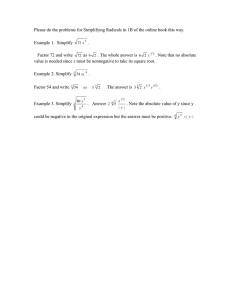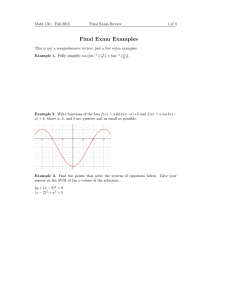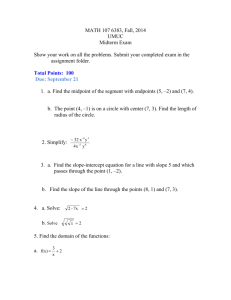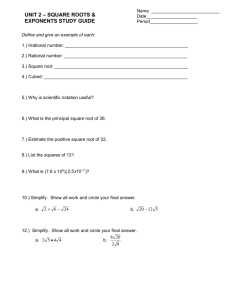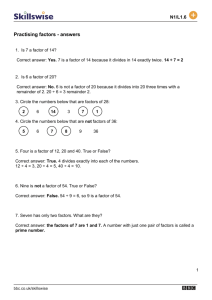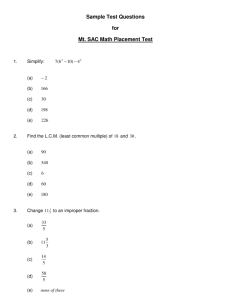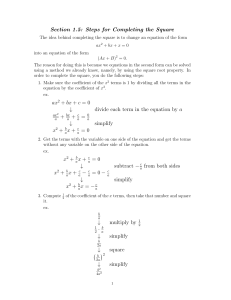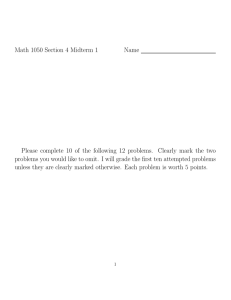Exam #1 Solutions
advertisement
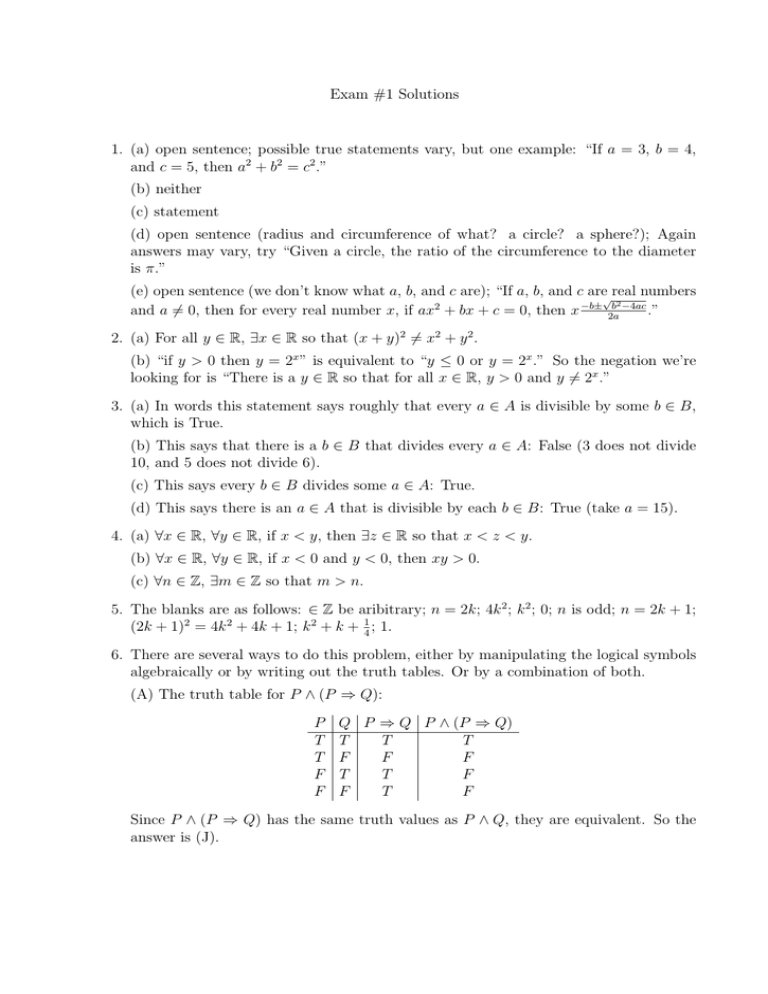
Exam #1 Solutions 1. (a) open sentence; possible true statements vary, but one example: “If a = 3, b = 4, and c = 5, then a2 + b2 = c2 .” (b) neither (c) statement (d) open sentence (radius and circumference of what? a circle? a sphere?); Again answers may vary, try “Given a circle, the ratio of the circumference to the diameter is π.” (e) open sentence (we don’t know what a, b, and c are); “If a, b, and c are√real numbers 2 and a 6= 0, then for every real number x, if ax2 + bx + c = 0, then x −b± 2ab −4ac .” 2. (a) For all y ∈ R, ∃x ∈ R so that (x + y)2 6= x2 + y 2 . (b) “if y > 0 then y = 2x ” is equivalent to “y ≤ 0 or y = 2x .” So the negation we’re looking for is “There is a y ∈ R so that for all x ∈ R, y > 0 and y 6= 2x .” 3. (a) In words this statement says roughly that every a ∈ A is divisible by some b ∈ B, which is True. (b) This says that there is a b ∈ B that divides every a ∈ A: False (3 does not divide 10, and 5 does not divide 6). (c) This says every b ∈ B divides some a ∈ A: True. (d) This says there is an a ∈ A that is divisible by each b ∈ B: True (take a = 15). 4. (a) ∀x ∈ R, ∀y ∈ R, if x < y, then ∃z ∈ R so that x < z < y. (b) ∀x ∈ R, ∀y ∈ R, if x < 0 and y < 0, then xy > 0. (c) ∀n ∈ Z, ∃m ∈ Z so that m > n. 5. The blanks are as follows: ∈ Z be aribitrary; n = 2k; 4k 2 ; k 2 ; 0; n is odd; n = 2k + 1; (2k + 1)2 = 4k 2 + 4k + 1; k 2 + k + 41 ; 1. 6. There are several ways to do this problem, either by manipulating the logical symbols algebraically or by writing out the truth tables. Or by a combination of both. (A) The truth table for P ∧ (P ⇒ Q): P Q P ⇒ Q P ∧ (P ⇒ Q) T T T T T F F F F T T F F F T F Since P ∧ (P ⇒ Q) has the same truth values as P ∧ Q, they are equivalent. So the answer is (J). (B) We simplify a little bit: 6= Q ⇒ ¬P is equivalent to Q ∨ ¬P , and ¬(P ∧ Q) is equivalent to ¬P ∨ ¬Q by de Morgan’s laws. Truth table: P Q Q ∨ ¬P ¬P ∨ ¬Q (¬Q ⇒ ¬P ) ∧ (¬(P ∧ Q)) T T T F F T F F T F F T T T T F F T T T This matches up with ¬P , so the answer is (I). (C) We convert the implications to OR statements: so ((P ⇒ Q) ⇒ Q) ⇒ P is equivalent to ¬((P ⇒ Q) ⇒ Q) ∨ P ⇔ ¬(¬(P ⇒ Q) ∨ Q) ∨ P ⇔ ¬(¬(¬P ∨ Q) ∨ Q) ∨ P, which we can simplify using de Morgan’s laws to ((¬P ∨ Q) ∧ ¬Q) ∨ P. From here we can write down the truth table, but we can also do the following. We can simplify further to ((¬P ∨ Q) ∧ ¬Q) ∨ P ⇔ ((¬P ∨ Q) ∨ P ) ∧ (¬Q ∨ P ). Since ¬P ∨ Q ∨ P is always true, we see that ((P ⇒ Q) ⇒ Q) ⇒ P ⇔ ¬Q ∨ P, which is equivalent to Q ⇒ P . So the answer is (G).
